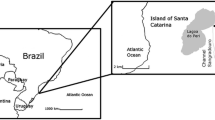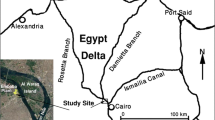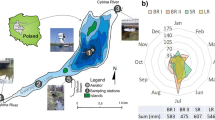Abstract
Redox processes during bank filtration were evaluated in Berlin, where bank filtered water is abstracted for drinking water production. The investigations included the mapping of the infiltration zone, a column study and hydrochemical analyses of the groundwater sampled between lake and production well. The organic carbon content increased and the permeability of the lake sediments decreased with distance from the shoreline. The most important changes with regard to the redox state of the infiltrate occurred within the first metre of flow. Infiltration was mostly anoxic, as oxygen was rapidly consumed within the organic rich sediments. The infiltration zone revealed a vertical redox stratification with hydrochemical conditions becoming more reducing with depth rather than with distance from the lake. The redox zones were found to be very narrow below the lake and wider towards the production wells, suggesting that other than differing flow paths, reaeration after infiltration may also occur and possible mechanisms are presented. Redox conditions were influenced by strong annual temperature variations of the surface water affecting the microbial activity. Aerobic infiltration only took place close to the shore in winter.










Similar content being viewed by others
References
Achten C, Kolb A, Püttmann W (2002) Occurrence of methyl tert-butyl ether (MTBE) in riverbank filtered water and drinking water produced by riverbank filtration. Environ Sci Technol 36:3662–3670
Agertved J, Rügge K, Barker JF (1992) Transformation of the herbicides MCPP and atrazine under natural aquifer conditions. Ground Water 30:500–506
Battin TJ, Sengschmitt D (1999) Linking sediment biofilms, hydrodynamics, and river bed clogging: evidence from a large river. Microb Ecol 37(3):185–196
Berner RA (1981) A new geochemical classification of sedimentary environments. J Sediment Petrol 51(2):0359–0365
Bosma TNP, Ballemans EMW, Hoekstra NK, Welscher RAG, Smeenk JGMM, Schraa G, Zehnder AJB (1996) Biotransformation of organics in soil columns and an infiltration area. Ground Water 34:49–56
Bourg CM, Bertin C (1993) Biochemical processes during the infiltration of river water into an Alluvial aquifer. Environ SciTechnol 27:661–666
Bourg ACM, Darmendrail D, Ricour J (1989) Geochemical filtration of riverbank and migration of heavy-metals between the Deule River and the Ansereuilles Alluvion-Chalk Aquifer (Nord, France). Geoderma 44(2–3):229–244
Bouwer H (2002) Artificial recharge of groundwater: hydrology and engineering. Hydrogeol J 10(1):121–142
Bouwer EJ, McCarty PL (1983) Transformations of halogenated organic compounds under denitrification conditions. Appl Environ Microbiol 45:1295–1299
Broholm MM, Tuxen N, Rügge K, Bjerg PL (2001) Sorption and degradation of the herbicide 2-methyl-4,6-dinitrophenol (DNOC) under aerobic conditions in a sandy aquifer in Vejen, Denmark. Environ SciTechnol 35:4789–4797
Brugger A, Reitner B, Kolar I, Quéric N, Herndl GJ (2001) Seasonal and spatial distribution of dissolved and particulate organic carbon and bacteria in the banks of an impounding reservoir on the Enns River, Austria. Freshw Biol 46:997–1016
Brunke M (1999) Colmation and depth filtration within streambeds: retention of particles in hyporheic interstices. Int Rev Hydrobiol 84(2):99–117
Busch K-F, Luckner L, Tiemer K (1993) Lehrbuch der hydrogeologie, Bd. 3. Geohydraulik; Bornträger, D-Berlin/Stuttgart
Champ DR, Gulens J, Jackson RE (1979) Oxidation-reduction sequences in ground water flow systems. Can J Earth Sci 16:12–23
Doussan C, Ledoux E, Detay M (1998) River-groundwater exchanges, bank filtration, and groundwater quality: ammonium behaviour. J Environ Qual 27(6):1418–1427
Dousson C, Poitevin G, Ledoux E, Detay M (1997) River bank filtration: modelling of the changes in water chemistry with emphasis on nitrogen species. J Contam Hydrol 25:129–156
Froehlich PN, Klinkhammer GP, Bender ML, Luedtke NA, Heath GR, Cullen D, Dauphin P (1978) Early oxidation of organic matter in pelagic sediments of the eastern equatorial Atlantic: suboxic diagnesis. Geochim Cosmochim Acta 43:1075–1090
Greskowiak J, Prommer H, Massmann G, Nutzmann G (2006) Modeling seasonal redox dynamics and the corresponding fate of the pharmaceutical residue phenazone during artificial recharge of groundwater. Environ SciTechnol 40(21):6615–6621
Grünheid S, Amy G, Jekel M (2005) Removal of bulk dissolved organic carbon (DOC) and trace organic compounds by bank filtration and artificial recharge. Water Res 39(14):3219–3228
von Gunten U, Kull TP (1986) Infiltration of inorganic compounds from the Glatt River, Switzerland, into a groundwater aquifer. Water Air Soil Pollut 29:333–346
von Gunten HR, Karametaxas G, Krähenbühl U, Kuslys M, Giovanoli R, Hoehn E, Keil R (1991) Seasonal biogeochemical cycles in riverborne groundwater. Geochim Cosmochim Acta 55:3597–3609
Haeffner H, Detay M, Bersillon JL (1998) Sustainable groundwater management using artificial recharge in Paris region. In: Peters JH (ed.) Artificial recharge of groundwater. A. A. Balkema, Amsterdam, pp 9–14
Heaton THE, Vogel JC (1981) ‘Excess-air’ in groundwater. J Hydrol 50:201–216
Hecht H, Kölling M (2002) Investigation of pyrite weathering processes in the vadose zone using optical oxygen sensors. Environ Geol 42(7):800–809
Hiscock KM, Grischek T (2002) Attenuation of groundwater pollution by bank filtration. J Hydrol 266:139–144
Hoehn E, Zobrist J, Schwarzenbach RP (1983) Infiltration von Flusswasser ins Grundwasser—hydrogeologische und hydrochemische Untersuchungen im Glattal. Gas Wasser Abwasser 8:401–410
Holm JV, Rügge K, Bjerg PL, Christensen TH (1995) Occurrence and distribution of pharmaceutical organic compounds in the groundwater downgradient of a landfill (Grindsted, Denmark). Environ Sci Technol 29(5):1415–1420
Holzbecher E, Dizer H, Grutzmacher Lopez-Pila J, Nutzmann G (2006) The influence of redox conditions on phage transport—enclosure experiments and modeling. Environ Eng Sci 23(4):623–630
Jacobs LA, von Gunten HR, Keil R, Kuslys M (1988) Geochemical changes along a river-groundwater infiltration flow path: Glattfelden, Switzerland. Geochim Cosmochim Acta 52:2693–2706
Juttner F (1999) Efficiency of bank filtration for the removal of fragrance compounds and aromatic hydrocarbons. Water Sci Technol 40(6):123–128
Kao CM, Chen SC, Wang JY, Chen YL, Lee SZ (2003) Remediation of PCE-contaminated aquifer by an in situ two-layer biobarrier: laboratory batch and column studies. Water Res 37:27–38
Kuehn W, Mueller U (2000) Riverbank filtration—an overview. J Am Water Works Assoc 92(12):60–69
Lensing HJ, Vogt M, Herrling B (1994) Modeling of biologically mediated redox processes in the subsurface. J Hydrol 159:125–143
Marmonier P, Fontvieille D, Gibert J, Vanek V (1995) Distribution of dissolved organic-carbon and bacteria at the interface between the Rhone River and its Alluvial aquifer. J North Am Benthol Soc 14(3):382–392
Massmann G, Pekdeger A, Merz C (2004) Redox processes in the Oderbruch Polder groundwater flow system in Germany. Appl Geochem 19(6):863–886
Massmann G, Greskowiak J, Dünnbier U, Zuehlke S, Knappe A, Pekdeger A (2006) The impact of variable temperatures on the redox conditions and the behaviour of pharmaceutical residues during artificial recharge. J Hydrol 328(1–2):141–156
Massmann G, Sültenfuß J, Dünnbier U, Knappe A, Taute T, Pekdeger A (2007) Investigation of groundwater residence times during bank filtration in Berlin—a multi-tracer approach. Hydrol Proc (in press)
Matsunaga T, Karametaxas G, von Gunten HR, Lichtner PC (1993) Redox chemistry of iron and manganese minerals in river-recharged aquifers: a model interpretation of a column experiment. Geochim Cosmochim Acta 57:1691–1704
Miettinen IT, Vartiainen T, Martikainen PJ (1996) Bacterial enzyme activities in ground water during bank filtration of lake water. Water Res 30(10):2495–2501
Okubo T, Matsumoto J (1983) Biological clogging of sand and changes of organic constituents during artificial recharge. Water Res 17(7):813–821
Patterson BM, Franzmann PD, Davis GB, Elbers J, Zappia LR (2002) Using polymer mats to biodegrade atrazine in groundwater: laboratory column experiments. J Contam Hydrol 54:195–213
Pavelic P, Nicholson B, Dillon PJ, Barry K (2005) Fate of disinfection by-products in groundwater during aquifer storage and recovery with reclaimed water. J Contam Hydrol 77(1–2):119–141
Pekdeger A, Sommer-von Jarmersted C (1998) Einfluß der Oberflächenwassergüte auf die Trinkwasserversorgung Berlins, Forschungspolitische Dialoge in Berlin—Geowissenschaft und Geotechnik, Berlin, pp 33–41
Petrunic BM, MacQuarriea KTB, Alb TA (2005) Reductive dissolution of Mn oxides in river-recharged aquifers: a laboratory column study. J Hydrol 301(1–4)
Prommer H, Stuyfzand P (2005) Identification of temperature-dependent water quality changes during a deep well injection experiment in a Pyritic aquifer. Environ SciTechnol 39(7):2200–2209
Richters L, Eckert P, Terrmann I, Irmscher R (2004) Untersuchung zur Entwicklung des ph-Wertes bei der Uferpassage in einem Wasserwerk am Rhein. Wasser Abwasser 145(9):640–645
Schubert J (2002) Hydraulic aspects of riverbank filtration—field studies. J Hydrol 266:145–161
Senat für Stadtentwicklung (2006) http://www.stadtentwicklung.berlin.de, cited 20 Dec 2006
Sophocleous M (2002) Interactions between groundwater and surface water: the state of science. Hydrogeol J 10:52–67
Tufenkji N, Ryan JN, Elimelech M (2002) The promise of bank filtration-a simple technology may inexpensively clean up poor-quality raw surface water. Environ Sci Technol 425 A
Tuxen N, Tüchsen PL, Rügge K, Albrechtsen H-J, Bjerg PL (2000) Fate of seven pesticides in an aerobic aquifer studied in column experiments. Chemosphere 41:1495–1494
Williams MD, Oostrom M (2000) Oxygenation of anoxic water in a fluctuating water table system: an experimental and numerical study. J Hydrol 230:(1–2):70–85
Acknowledgments
The study was conducted within the NASRI (Natural and Artificial Systems for Recharge and Infiltration) project of the Kompetenzzentrum Wasser Berlin (KWB gGmbH). The authors would like to thank Veolia Water and the Berliner Wasserbetriebe (BWB) for financing the study. We would also like to thank Dr. Birgit Fritz from the KWB in Berlin, Dr. Uwe Dünnbier from BWB as well as Bettina Ohm, Oliver Menzel and Anne Beck from the Freie Universität Berlin for their support. We acknowledge the contributions of Elke Weiß and Silke Meier at the Freie Universität Berlin and colleagues in the laboratories of the Berliner Wasserbetriebe.
Author information
Authors and Affiliations
Corresponding author
Rights and permissions
About this article
Cite this article
Massmann, G., Nogeitzig, A., Taute, T. et al. Seasonal and spatial distribution of redox zones during lake bank filtration in Berlin, Germany. Environ Geol 54, 53–65 (2008). https://doi.org/10.1007/s00254-007-0792-9
Received:
Accepted:
Published:
Issue Date:
DOI: https://doi.org/10.1007/s00254-007-0792-9




